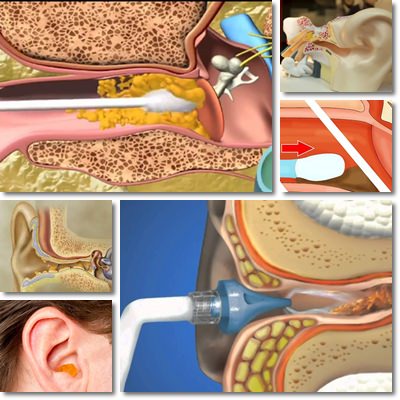Also known as cerumen, earwax is the yellow wax-like substance secreted by special glands in our ear canal. While it is normal for it to differ slightly in terms of appearance, consistence and amount, major differences such as a buildup consistent enough to muffle hearing or reddish or black color require the attention of a medical professional.
Aside from a few characteristics which fall into the normal range, any major and disturbing change in earwax appearance is likely to indicate the onset of an infection or other medical condition.
What is earwax?
Earwax is a wax-like secretion produced by sebaceous and modified sweat glands in our ear canal. It is produced with the purpose of protecting the opening of the ear. After it is secreted, earwax slowly travels towards the opening of the ear canal along with any particles that might have made their way in, thus preventing any potential infection. Moreover, recent studies suggest earwax has natural antimicrobial and even antifungal properties and can actively help prevent ear infections by stopping bacteria and fungi growth.
So having earwax is a good sign as it’s good for the health of the entire ear.

What does earwax look like?
Earwax is basically a combination of various particles and secretions whose main purpose is to protect the ear against infection.
There are two main types of earwax:
1) Wet earwax
This is common in European and African peoples. It is called wet earwax because it has a softer consistency, resembling candle wax when it’s warm and about to melt. This type of earwax generally has a golden-brown color.
2) Dry earwax
This type is common in Asian and Native American peoples. It is called dry earwax because it has a dry consistency, looking a lot like dry skin flakes. This type of earwax has a whitish-grayish color.
Earwax is genetically determined
The wet type contains more fatty material than the dry type, hence its softer, more viscous consistency. It is believed that dry earwax is an adaptation to colder climates, while wet earwax is common in people with ancestors from warmer climates.
Wet earwax has also been linked with increased perspiration, a mechanism of thermo-regulation that is meant to help people living in warmer climates cool down in response to their environment.

What is ear wax made of?
Earwax is a combination of several components, the majority of which are more or less viscous secretions produced by special sebaceous and modified sweat glands in our ear. Dead skin cells and keratin, sweat, saturated and unsaturated long chain fatty acids, alcohols such as cholesterol and squalene (organic compound that helps synthesize cholesterol, vitamin D and hormones) are also major components of earwax.
How is earwax made?
Earwax is made in an area between the middle and the outer ear. This is where sebaceous glands and modified apocrine glands called ceruminous glands (from cerumen), which produce an oily secretion are located. After it is produced, earwax slowly travels from the eardrum towards the entrance to the ear canal to be expelled along with any particles that might have made their way in (such as dust).
This is a natural process that allows the ear to cleanse itself and a protection mechanism that helps prevent infections.
Functions and benefits of earwax
Why do we have ear wax? Having earwax is crucial for ear health and serves several important purposes:
1) Protection against infection
Earwax coats the skin of the ear canal and protects the eardrum. Thanks to it, any water that may get inside our ear when we shower or swim simply rolls out without soaking the skin. If the ear is in contact with water too often, then there might not be sufficient earwax to protect the ear from moisture and infections such as external otitis (such as swimmer’s ear) may occur. This is because moisture creates the perfect environment for bacteria growth.
2) Natural cleaning and lubrication purposes
Because of its consistency, earwax helps keep the skin inside the ear moist, preventing it from drying out. The lipids in the cerumen are the ones that help preserve moisture. Moreover, as earwax progresses towards the exit of the ear canal, it takes with it any external particles (dust, sand, pollen) that might have made their way inside. This self-cleaning mechanism occurs naturally and helps prevent both infection and earwax buildup that may cause muffled hearing and other long-term hearing problems.
3) Antimicrobial effects – has antibacterial and antifungal properties
According to more recent research, earwax exhibits antimicrobial properties against several bacteria and fungi strains. Earwax may protect against Escherichia coli, Staphylococcus aureus etc. as well as several fungus strains. It is believed that the saturated fatty acids and acidic pH of earwax are the reason why opportunistic microbes do not infect the ear.
How to clean ears and earwax properly
Generally washing our hair is enough to help clear earwax deposits as the water that pours down our head will soften and clean out the earwax that has already migrated towards the outside of the ear canal, which is the only earwax you need to clean really. Gently drying the outside of the ear canal with a clean washcloth is enough.
While our ears do clean themselves naturally, some people may need to clean their ear canal manually to help take out any earwax deposits.
However, this should be done very carefully to avoid damaging the skin of the ear canal or perforate the eardrum. Using a soft washcloth or towel previously soaked in warm water to help soften the earwax deposits and allow for gentle cleaning.
Why you shouldn’t use cottons swabs to clean your ears
Using cotton swabs should be avoided because, unless the earwax is soft, and even then, they can push it further in and cause it to become compacted.
This can block sound and lead to hearing problems. Pushing the cotton swab too far inside the ear canal can hurt the eardrum or perforate it which will lead to hearing problems and hearing loss.
Cleaning earwax plugs is best done by a medical professional to prevent any complications.
Experts agree that softening problematic earwax deposits using lukewarm water or special oils such as baby oil, olive oil etc. can help soften the wax and encourage its elimination.
Other ceruminolytics or cerumenolytics (substances introduced into the external ear canal to help soften wax) include: hydrogen peroxide-urea, glycerin, sodium bicarbonate, sodium docusate or commercial ceruminolytics.
While a lot of earwax cleaning products are available, regulated and certified as safe for use, the first course of action when undertaking ear cleaning is to use warm water and a clean washcloth.
This should be enough. If simple cleaning fails, you may try the various products available. It’s important to see your doctor if you experience hearing issues, a feeling of blocked or clogged ears, redness, itching, swelling or pain.
Disadvantages of cleaning earwax
Water in the ear canal can encourage an infection. For this reason, a saline solution is recommended as an alternative to plain water to reduce risks of infection. However, know that it’s not the actual water used to clean earwax that increases risks of infection, but rather the water stagnating in the ear canal.
Hydrogen peroxide which a lot of people use, and recommend, for cleaning earwax and ears, may cause tissue scarring or hearing problems and should not be used, especially if you have eardrum perforations. Commercial ceruminolytics come with their own set off side effects. Because the ear canal is a highly sensitive area, it is best to avoid any invasive procedures and harsh products that may damage it physically or cause an imbalance affecting normal function.
